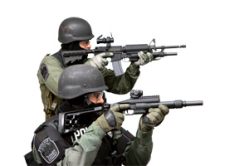MAUL FOR MORE FIREPOWER
PHOTO // Courtesy of Metal Storm
The MAUL multi-fire shotgun made by Australia-based firm Metal Storm packs not just one punch but five, as the weapon can take five 12-gauge shells in a single load.
Although shotguns are hardly precision weapons and lack the sexy one-shot-one-kill capability of sniper weapons, their true value lies in the sheer number of projectiles they can deliver with each shot. When it comes to densely-packed urban environments, nothing strikes as much fear into the hearts of adversaries than the sight of a shotgun.
Traditionally, shotguns have been used by the military mostly in close-quarter fighting and jungle warfare. However, as the additional weapon means a heftier load for infantry squads who travel mostly by foot, shotguns are rarely used by military forces other than in Special Forces operations.
Another drawback of traditional shotgun designs is the inability to fire multiple rounds without reloading. Those that could - such as double-barrelled guns - presented the disadvantage of increased weight as these guns were essentially two weapons fused together.
All this changed with the entry of Metal Storm s MAUL in mid-2009. MAUL, which stands for Multi-Shot Accessory Under-barrel Launcher, uses 12-gauge shells - one of the most popular shotgun gauge sizes - and is an ultra-light shotgun attachment for assault rifles. It can also be deployed alone, thanks to an optional foldable stock attachment.
Lightweight yet powerful
Weighing in at 1.8 pounds (820g), what the MAUL lacks in heft it makes up for in firepower. Capable of firing five rounds per ammunition load, as fast as the user can squeeze the trigger, the MAUL is a powerful rapid-fire system.
To achieve this, the MAUL employs specially-developed ammunition, also known as super-imposed rounds because the rounds are stacked on top of one another, and an electronic ignition system.
The special ammunition allows the rounds to be loaded sequentially - like batteries in a torchlight - and fired off in succession without the complicated ammunition-loading and ejecting mechanisms commonly used by other small arms. The electronic ignition is what allows the firing of rounds positioned at different parts of the barrel. This is a crucial part of the MAUL's design, without which all the rounds will ignite at the same time.
All its rounds are housed in a lightweight carbon-fibre sleeve which is inserted into the front end of the MAUL where the electronic firing system also resides. This tube-assembly doubles up as a barrel, eliminating the need for a traditional barrel made of heavy steel which accounts for much of the weight in traditional shotgun systems. Rapid insertion and removal of tubes loaded with mission-specific ammunition is a cinch, as compared to traditional shotguns where rounds are inserted one by one after each firing.
Ready and versatile
The MAUL can be attached to popular assault rifles such as the M-4 and M-16, under the rifle s barrel assembly via the commonly found Picatinny rail (a standardised mounting platform). When not required, the MAUL can be easily removed without compromising the host weapon s ability to function.
This integration with a parent weapon is further enhanced by boresight-alignment, which simply means that the firer can use a single set of aiming sights - usually that found on the host weapon - to fire the MAUL.
With so much power on tap, the MAUL is also careful to protect its firer. Safety features include both mechanical and electrical interlocks, which make it virtually impossible to fire the MAUL by accident. To fire off the sequentially-loaded rounds electronically, the MAUL draws its electricity supply from a standard military-grade lithium-ion cell. According to Metal Storm, a single battery is sufficient for months of use.
MAUL going places
Although only two round types have been developed for the MAUL - a lethal slug with great stopping power and a non-lethal blunt impact round - more are being developed to improve the weapon's versatility.
According to Dr Lee Finniear, Chief Executive Officer of Metal Storm, a complete suite of both lethal and non-lethal projectiles for the MAUL is being developed.
"We are looking forward to the completion of our munitions expansion programme where we will be able to meet the growing demand for our product," said Peter Faulkner, General Manager and primary MAUL Project Manager of Metal Storm.
Initially contracted by the United States Marine Corps to develop a door-breaching capability, Metal Storm was later asked by the US Office of Naval Research to build a weapon with a similar capability, which resulted in the MAUL. Following a successful test-firing in April 2009, the Defence Research and Development Canada - a government agency - purchased a small quantity of Metal Storm s MAUL weapons in November 2009 for evaluation.
The MAUL can be attached to common assault rifle platforms such as the M-4 and M16 via Picatinny rails. It is pictured here attached to an M-4 assault rifle.
The MAUL can also be used alone with the pictured shoulder stock attachment.










